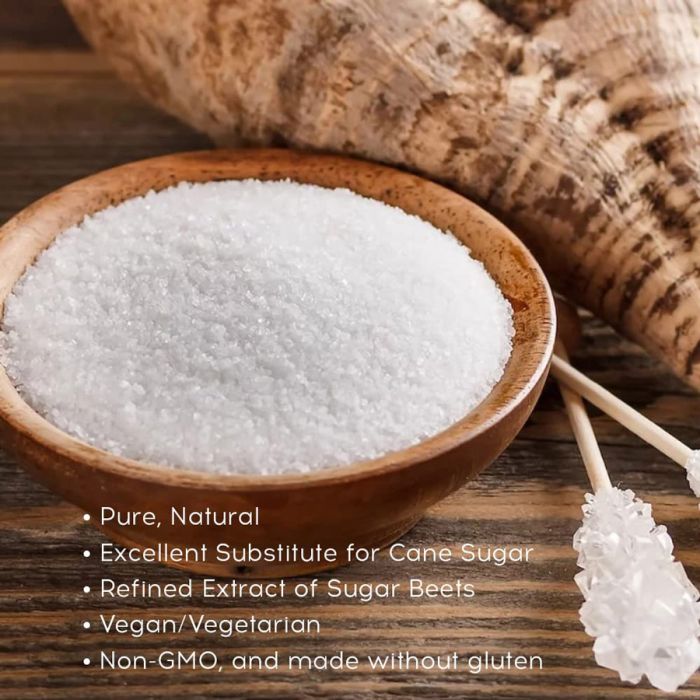The refining process of beet sugar vs cane sugar differs, affecting the final product’s characteristics.
Discovering the Differences in Uses and Advantages Between Beet Sugar Vs Cane Sugar
In the cooking globe, the choice between beet sugar and cane sugar is not just about sweetness however entails a nuanced consideration of taste, application, and influence. While both sugars stem from different plants, each goes through one-of-a-kind production procedures that subtly influence their characteristics and suitability for numerous dishes.
Origins and Production Procedures of Beet and Cane Sugar

Walking stick sugar, on the various other hand, comes from the sugarcane plant, a tropical lawn belonging to Southeast Asia today cultivated in tropical zones worldwide. The production of cane sugar starts with the harvesting of cane stalks, which are crushed to release the juice. This juice is then steamed to focus it, after which it is rotated in centrifuges to generate raw sugar crystals. These crystals are more improved to generate the white sugar generally available in stores.

Nutritional Content and Wellness Considerations

When comparing the nutritional content of beet sugar and cane sugar, it becomes obvious that both kinds basically supply the very same caloric values, with around 16 calories per tsp and no considerable nutrient variety. Each is made up nearly totally of sucrose, which is a simple carbohydrate that offers fast power yet does not have vitamins, minerals, or fiber. This resemblance reaches their influence on health, especially worrying blood sugar level degrees. Both sugars, when eaten in excess, can add to elevated blood sugar degrees, a danger variable for diabetes mellitus and other metabolic problems. Additionally, extreme intake can bring about weight gain and dental problems, as both sugars are just as cariogenic, promoting dental cavity. From a wellness point of view, moderating consumption of any kind of sugar, whether from beet or cane, is a good idea to avoid these possible negative results on wellness. Hence, neither holds an unique benefit over the other in regards to health advantages.
Flavor Accounts and Culinary Applications
Regardless of their comparable chemical frameworks, beet sugar and pop over here cane sugar vary subtly in taste, which can affect their use in different cooking contexts. Walking cane sugar commonly lugs a hint of molasses, even in its polished form, providing a cozy, caramel-like touch that enhances baked products, coffee, and chocolate-based recipes. This minor molasses flavor is particularly valued in the cooking market for adding deepness to desserts and breads. On the various other hand, beet sugar is identified by its very improved, neutral preference, making it a flexible sugar that does not change the flavor profiles of dishes. This nonpartisanship is specifically advantageous in delicate recipes, such as light pastries, creams, and some sauces, where the inherent flavors of various other active ingredients are planned to stick out. Subsequently, chefs and food producers might pick one kind of sugar over the various other based on the desired taste result of their culinary creations.
Environmental Influence and Sustainability
While both beet and cane sugars are derived from plants, their environmental effects differ significantly due to the distinct techniques of growing and handling needed for each. Sugar beet farming frequently entails extensive mechanization, which can enhance fossil gas intake and carbon emissions.
Furthermore, the handling of sugarcane often produces a considerable quantity of waste, consisting of bagasse, which, although useful as biofuel, regularly contributes to air contamination if shed inefficiently. Sugar beet processing uses more of the raw products, causing much less waste. Both industries deal with go to website obstacles in decreasing their ecological impacts, but ongoing developments in farming techniques and waste management are aiming to improve sustainability.
Economic Aspects Influencing the Sugar Market
The economic characteristics of the sugar industry are substantially influenced by worldwide market demands and trade plans. Elements such as tolls, subsidies, and worldwide trade contracts play essential duties in shaping the competitive landscape. In regions where sugarcane or sugar beet manufacturing is subsidized, producers might have a financial benefit that enables them to provide reduced prices on the international market. This can create differences in earnings and market gain access to for producers in nations without such subsidies.
Additionally, changes in international demand for sugar, influenced by dietary fads and industrial use in food, straight impact prices and manufacturing levels. beet sugar vs cane sugar. Weather also Continued play a crucial duty, as they can dramatically influence plant returns and, subsequently, the supply chain. This irregularity presents a degree of economic uncertainty that can result in investment volatility in sugar production sectors, influencing decisions from growing to market strategy
Final Thought
In conclusion, both beet and cane sugar have unique high qualities that fit different culinary needs. While cane sugar conveys an abundant taste perfect for enhancing baked products, beet sugar's nonpartisanship is ideal for lighter dishes.